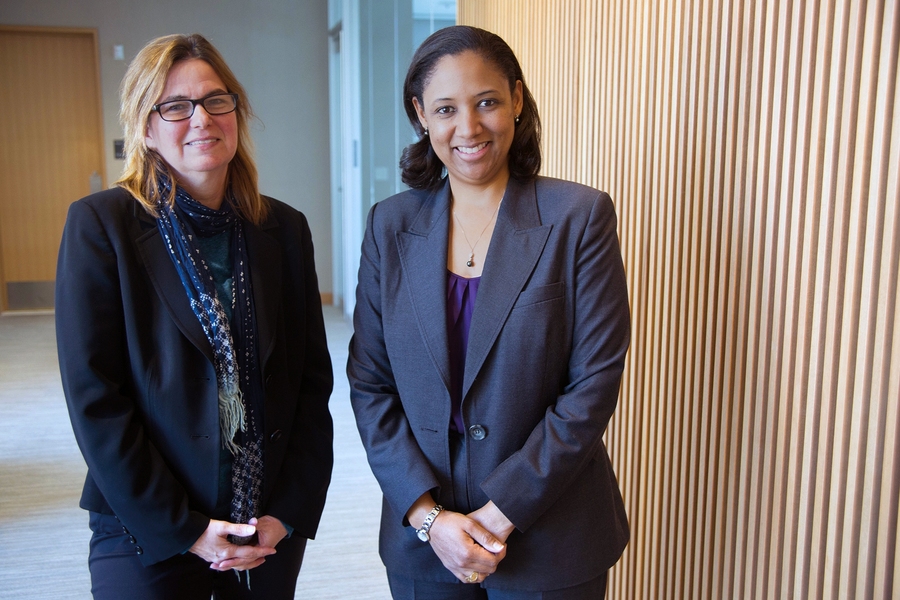The MIT Energy Initiative (MITEI) continues to develop and expand its eight Low-Carbon Energy Centers, which facilitate interdisciplinary collaboration among MIT researchers, industry, and government to advance research in technology areas critical to addressing climate change. Here, the directors of the center focused on energy bioscience — Angela M. Belcher, the James Mason Crafts Professor of Biological Engineering and Materials Science, and Kristala L.J. Prather, the Arthur D. Little Professor of Chemical Engineering — discuss their vision for transforming the energy system.
Q: How can bioscience research help the world reach its goal of reducing carbon emissions?
A: For billions of years, biology has employed an approach to energy generation and the synthesis of materials and chemicals that meets the needs of organisms with minimal production of byproducts that are poisonous to the environment. Bioscience is tapping into this vast toolset to transform today’s carbon-centric energy systems by creating new structures, devices, and materials that are significantly less energy-intensive and less harmful to the environment than today’s dominant energy technologies.
What’s exciting is that, while it took biology 4 billion years of trial and error to develop its extraordinarily efficient systems, modern bioscience techniques enable researchers to conduct a billion experiments in a matter of months. As a result, the field of synthetic biology, which is only about 15 years old, has already produced startling results.
At MIT, researchers working on energy-related applications have successfully engineered microorganisms to make biofuel from an assortment of starting substrates and used viruses to build batteries, sensors, and more efficient solar cells.
Q: How will the new Center for Energy Bioscience Research identify and address the major challenges in this area?
A: The center partners with a diverse set of private companies, government entities, and non-governmental organizations to ensure that MIT develops practical biological and biologically inspired energy solutions to a wide range of concerns — from developing cleaner fuel sources to enhancing storage options, and from fueling new transportation alternatives to cleaning up the environment.
Drawing upon MIT’s extensive existing research capability in synthetic biology, microbial metabolic engineering, new DNA technologies, and directed evolution, the center plans to rapidly screen, model, design, and synthesize new materials with biological fidelity to harness the power of biology to shape a low-carbon future.
Q: What kind of research is currently under way at the center?
A: One promising development is the biological generation of liquid fuels from natural gas. It has been estimated that the proven reserves of natural gas (methane) in the United States could sustain the transportation sector of this country for the next 50 years. However, methane’s low energy density makes it unsuitable for integration into current infrastructure.
MIT researchers are investigating biological processes for the low-cost conversion of methane to liquid fuel molecules with much higher energy density. For example, researchers have developed a novel bioprocess for converting syngas (obtainable from methane) or other waste gases containing carbon dioxide and a reducing gas such as hydrogen or carbon monoxide into biofuel. The process uses bacteria to convert waste gases into acetic acid — vinegar — which is subsequently converted to oil by an engineered yeast.
MIT researchers have also developed a virus that can improve solar cell efficiency by nearly one-third and demonstrated a technique that can significantly increase the photosynthetic activity of plants. Such increased activity could result in faster production of biomass for biofuel production, leading to faster capture and fixation of carbon dioxide from the atmosphere.
On a broader scale, MIT researchers have recently developed a programming language for bacteria that makes it quicker and easier to create designer DNA for genetic parts such as sensors, memory switches, and biological clocks. Such parts can then be combined to modify existing cell functions and add new ones. This work promises to be useful in a wide range of energy applications, such as designing yeast that could ferment biomass into ethanol without toxic byproducts.
This article appears in the Spring 2017 issue of Energy Futures, the magazine of the MIT Energy Initiative.






